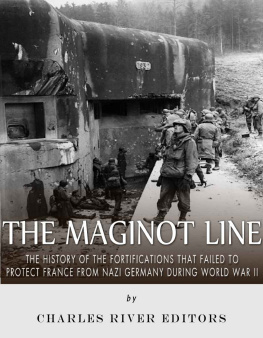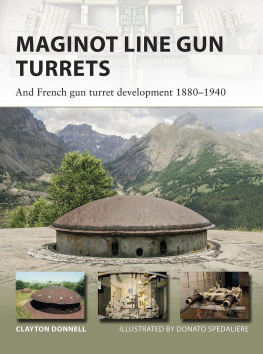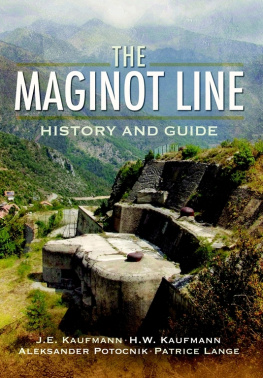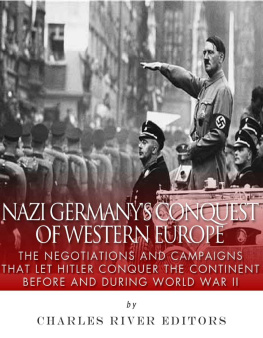Charles River Editors provides superior editing and original writing services across the digital publishing industry, with the expertise to create digital content for publishers across a vast range of subject matter. In addition to providing original digital content for third party publishers, we also republish civilizations greatest literary works, bringing them to new generations of readers via ebooks.
Sign up here to receive updates about free books as we publish them , and visit Our Kindle Author Page to browse todays free promotions and our most recently published Kindle titles.
Introduction

A picture of one of the Maginot Lines turrets
The Maginot Line
We could hardly dream of building a kind of Great Wall of France, which would in any case be far too costly. Instead we have foreseen powerful but flexible means of organizing defense, based on the dual principle of taking full advantage of the terrain and establishing a continuous line of fire everywhere. Andre Maginot, French Minister of War, 1929
As the power of Nazi Germany grew alarmingly during the 1930s, the French sought means to defend their territory against the rising menace of the Thousand-Year Reich. As architects of the most punitive measures in the Treaty of Versailles following World War I, the French government made natural targets for Teutonic retribution, so the Maginot Line, a series of interconnected strongpoints and fortifications running along much of France's eastern border, helped allay French fears of invasion.
The popular legend of the Maginot Line portrays the frontier defenses as a useless white elephant project that was prompted by a gross misapprehension of warfare's new realities in the mid-20th century and quickly overwhelmed by the forceful advance of the German blitzkrieg. English idiom today invokes this vision of the Maginot Line as a metaphor for any defensive measure strongly believed in but actually useless.
Indeed, usages such as Maginot Line mentality, describing an overly defensive, reactive mindset, perpetuate the legend. As a French author and military liaison with the British, Andre Maurois, wrote about his disillusionment with the defensive line he originally enthusiastically supported: We know now that the Maginot line-complex was a dangerous disease of the mind; but I publish this as it was written in January, 1940.
In reality, however, the actual Maginot Line proved considerably more functional than memory has served. The true flaw in French military strategy during the opening days of World War II lay not in reliance on the Maginot fortifications but in the army's neglect to exploit the military opportunities the Line created. In other words, the border defense performed as envisioned, but the other military arms supported it insufficiently to halt the Germans. The French Army squandered the opportunity not because the Maginot Line existed but because they failed to utilize their own defensive plan properly. Some French commentary contributed to the legend, but the bloviating of politicians altered nothing regarding the Maginot Line's actual purpose or history: General Maurin, defended the status quo in these words: [H]ow could one think that we are still thinking about an offensive when we have spent billions to establish a fortified barrier? Would we be mad enough to advance beyond this barrier to undertake some adventure? [...] but the Maginot Line had never been conceived as a sort of Great Wall of China sealing France off from the outside world. Its purpose was to free manpower for offensive operations elsewhere. (Jackson, 2004, 27).
In fact, a forgotten battle in the southeast of France, where four French divisions (later reduced to three by the redeployment of one northwards in a futile effort to stem the German tide) held off 32 Italian divisions thanks to the defensive power of the so-called Little Maginot Line of the Alps, proved the soundness of both the concept and engineering. Though the Italians suffered from poor equipment and the meddling incompetence of Mussolini's personal leadership, the fighting on the Alpine front brilliantly highlighted the Maginot Line's success as a force multiplier. French soldiers held off brave but futile Italian attacks at odds of 8:1 or 10:1 in favor of the Italians for five days until an armistice with the Axis put an end to this undeniable display of the Maginot Line's effectiveness.
The Maginot Line: The History of the Fortifications that Failed to Protect France from Nazi Germany During World War II chronicles the background and construction of the much maligned defensive fortifications. Along with pictures of important people, places, and events, you will learn about the Maginot Line like never before, in no time at all.
Chapter 1: World War I and the Origins of the Maginot Line
At eleven oclock this morning came to an end the cruellest and most terrible War that has ever scourged mankind. I hope we may say that thus, this fateful morning, came to an end all wars. David Lloyd George, November 11th, 1918
By November 1918, despite tens of thousands of Allied casualties suffered while securing the Selle and le Cateau, the German army was virtually spent as a fighting force. Hundreds of thousands of German soldiers were dead, incapacitated or captured, many of them irreplaceable veterans. Germany simply could not field more soldiers than were being lost, even by calling up age classes which had been considered ineligible for mobilization at the start of the war, or fudging the numbers by forcing sick or wounded men to take up arms. Additionally, the Royal Navy blockade ensured that Germany was virtually bereft of supplies, so the rations received by soldiers on the front were increasingly insufficient to meet their needs or absent altogether. There was also a dearth of ammunition and medical supplies, not to mention machineguns and light and heavy artillery pieces, of which the Allies had captured hundreds in their lightning advance.
In early November, the British First, Third and Fourth Armies, alongside the French First Army and the AEF divisions now emerging from the Argonne, launched what would be their final advance against the German army. Advancing across a 30-mile front, the Allies would harass the Germans and prevent them from carving out another defensive line on the eastern bank of the Meuse.
On November 4 th , at 0500, 17 British and 11 French divisions launched a massive assault. Unlike the previous offensives of the Hundred Days, there would be no massed deployment of armor to shield the advance of the infantry. Battlefield attrition and mechanical failure had taken their toll, and the Royal Tank regiment had managed to muster less than 40 tanks for the attack. As a result of this, casualties among the leading infantry divisions were high. Leading the vanguard, XIII and IX Corps of the British Army ran into the Sambre Canal, an obstacle nearly 70 feet wide. Caught in the open, the XIII and IX corps were decimated by German artillery, which poured a murderous barrage on the attackers. Over a thousand British soldiers were killed in crossing the canal, which was eventually accomplished by throwing temporary bridges across the water under the lead of Lt. Colonel Johnson, who won the Victoria Cross doing so.


















